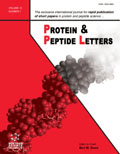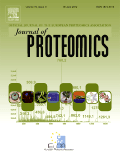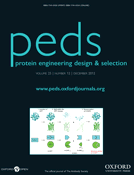
PROTEIN AND PEPTIDE LETTERS
Scope & Guideline
Exploring the forefront of biochemistry and structural biology.
Introduction
Aims and Scopes
- Protein Structure and Function:
The journal publishes studies that explore the structural properties of proteins, their dynamics, and how these attributes relate to their biological functions. - Peptide Therapeutics and Drug Development:
Research on bioactive peptides, their mechanisms of action, and their potential applications in drug development and therapeutic interventions is a core focus. - Proteomics and Mass Spectrometry:
Innovative proteomic techniques, including mass spectrometry, are frequently featured, highlighting advancements in protein analysis and biomarker discovery. - Molecular Biology and Genetic Engineering:
The journal includes articles on the molecular mechanisms underlying gene expression, protein synthesis, and the use of genetic engineering techniques to modify proteins and peptides. - Biotechnology and Bioengineering Applications:
Studies that apply protein and peptide research to biotechnological processes, including enzyme engineering and the development of novel biomaterials, are emphasized. - Cancer Biology and Therapeutics:
There is a significant focus on the roles of proteins and peptides in cancer biology, including studies on oncogenic pathways and potential therapeutic targets. - Immunology and Vaccine Development:
Research related to the immunogenicity of proteins and peptides, including their use in vaccine development and immune response modulation, is also a key area of interest.
Trending and Emerging
- Protein-Protein Interactions and Networks:
There is a rising interest in studying protein-protein interactions and their implications in cellular networks, which is crucial for understanding complex biological processes. - Bioinformatics and Computational Biology:
The integration of bioinformatics tools to analyze protein structures, functions, and interactions is becoming more prevalent, facilitating deeper insights into protein science. - Peptide-Based Nanocarriers and Drug Delivery Systems:
Research on utilizing peptides as nanocarriers for drug delivery is on the rise, showcasing innovative approaches to enhance the bioavailability and efficacy of therapeutics. - Targeted Cancer Therapy:
A growing number of studies focus on the development of targeted therapies using engineered proteins and peptides, particularly in oncology, reflecting a shift towards personalized medicine. - Microbiome and Host Interactions:
Emerging research exploring the role of proteins and peptides in microbiome interactions and their effects on host health is gaining prominence, indicating a broader understanding of health and disease. - CRISPR and Gene Editing Technologies:
The applications of CRISPR and other gene-editing technologies in protein engineering and therapeutic development are increasingly being featured, highlighting their revolutionary impact on biotechnology.
Declining or Waning
- Traditional Enzymology:
Research focusing solely on classical enzymatic mechanisms without broader implications for protein engineering or therapeutic applications is waning, as interest shifts towards more applied and innovative approaches. - Basic Biochemical Pathways:
While foundational studies are essential, there is a noticeable decline in the publication of papers that exclusively describe basic metabolic pathways without integrating into larger biological or therapeutic contexts. - Agricultural Proteomics:
The application of proteomics specifically in agricultural settings, such as crop improvement, seems to be less emphasized in recent issues, indicating a shift towards more clinical and biomedical applications. - In Vitro Studies without Clinical Relevance:
Studies that focus solely on in vitro experiments without clear pathways to clinical application or relevance are becoming less common, as the journal seeks more translational research. - Historical Reviews on Protein Functions:
The journal appears to be moving away from historical reviews that do not incorporate current research trends or implications, favoring more forward-looking studies.
Similar Journals

BIOCHEMISTRY-MOSCOW
Elevating Knowledge in Biochemistry and GeriatricsBIOCHEMISTRY-MOSCOW is a distinguished academic journal published by MAIK NAUKA/INTERPERIODICA/SPRINGER, focusing on pivotal research in the fields of biochemistry, biophysics, geriatrics, and broader medical sciences. Established in 1972, the journal has a rich history of disseminating critical findings and innovative studies, making significant contributions to the advancement of biochemical knowledge and applications. With its Q2 ranking in various categories including biochemistry and gerontology, the journal commands respect within the scientific community, offering a reputable platform for both established researchers and emerging scholars alike. Although traditionally not an open-access journal, it provides a wealth of information accessible through institutional subscriptions, ensuring the latest advancements reach a global audience. The journal aims to enhance understanding of biochemical processes and their implications for human health, and its commitment to high-quality peer-reviewed content has established it as a vital resource for those invested in the life sciences.

Journal of Proteomics
Innovating methodologies for groundbreaking discoveries.Journal of Proteomics, published by Elsevier, is an esteemed peer-reviewed journal dedicated to advancing research in the field of proteomics, with broad implications for biochemistry and biophysics. Established in 2008, the journal has continuously evolved, embracing innovative methodologies and technologies that facilitate protein analysis from a variety of biological systems. With its current standing in the Q2 category for both biochemistry and biophysics as of 2023, it is recognized as a significant contributor to scientific literature. The journal publishes original research articles, reviews, and methodological advancements, providing invaluable insights for researchers, professionals, and students alike. Although it does not offer open access, the journal remains a crucial platform for disseminating knowledge that informs various applications, ranging from drug development to disease understanding. As it converges towards 2024, the Journal of Proteomics continues to solidify its role in shaping the future of proteomic research through rigorous scientific inquiry and innovation.

Peptide Science
Unlocking the potential of peptides in science.Peptide Science, published by Wiley, is an esteemed journal dedicated to advancing the understanding of peptide chemistry and its applications across various scientific disciplines, including biochemistry, biophysics, and organic chemistry. Since its inception in 2018 and continuing through 2024, this journal has provided an essential platform for the dissemination of innovative research, engaging articles, and critical reviews. With an impressive Q3 ranking in the fields of Biochemistry and Biomaterials, and a Q2 status in Biophysics and Organic Chemistry as of 2023, Peptide Science acknowledges its integral role in addressing significant scientific challenges. This open-access journal ensures that findings are readily available to a global audience, fostering collaboration and knowledge sharing among researchers, professionals, and students alike. The journal exemplifies excellence in scholarly communication, making it an essential resource for anyone interested in the intricate world of peptide research.

PROTEIN ENGINEERING DESIGN & SELECTION
Elevating Protein Engineering to New HeightsPROTEIN ENGINEERING DESIGN & SELECTION is a leading journal published by Oxford University Press that focuses on the intricate field of protein engineering, encompassing biochemistry, bioengineering, and biotechnology. With an ISSN of 1741-0126 and E-ISSN 1741-0134, this journal aims to disseminate groundbreaking research and innovative methodologies related to protein design and selection, enhancing our understanding of molecular biology and its applications in medicine and industry. With an established record from its inception in 1986 to the present, it maintains a significant influence in the academic community, reflected in its categorization in Q2 across various fields in its latest 2023 metrics. Although it is not an open-access journal, it offers invaluable insights and robust peer-reviewed contributions that are essential for both experienced researchers and emerging scholars in the field. The journal aspires to not only advance scientific knowledge but also to engage with real-world challenges through collaborative research and innovative practices, reinforcing its position in the evolving landscape of biotechnology and protein sciences.

ACS Chemical Biology
Unraveling the Chemistry Behind Biological InnovationACS Chemical Biology is a premier journal published by the American Chemical Society, dedicated to advancing the understanding of the chemical underpinnings of biological systems. With an ISSN of 1554-8929 and a distinguished track record since its inception in 2006, this journal provides a vital platform for the dissemination of high-quality research in the realms of biochemistry and molecular medicine, achieving a prestigious Q1 ranking in these categories as of 2023. In an era where interdisciplinary approaches are crucial, ACS Chemical Biology fosters collaboration among chemists and biologists, reflecting a steadfast commitment to exploring the chemical processes that govern life. Although it does not operate under an open-access model, the journal maintains a rigorous peer-review process, ensuring the publication of influential studies that shape the future of chemical biology. With an increasing impact factor and a focus on innovative research, ACS Chemical Biology remains an authoritative resource for researchers, professionals, and students eager to engage with cutting-edge findings in this dynamic field.

JOURNAL OF BIOLOGICAL CHEMISTRY
Advancing the Frontiers of Biochemical ResearchJOURNAL OF BIOLOGICAL CHEMISTRY, published by Elsevier, is a premier interdisciplinary journal dedicated to advancing our understanding of biochemistry, cell biology, and molecular biology. With a prestigious history dating back to 1945 and an impressive convergence of research expected to continue through 2024, this journal holds a Q1 ranking in all three of its core categories, signaling its critical influence in the respective fields, supported by a robust Scopus ranking that places it among the top echelons of internationally recognized research. Although currently not available as Open Access, the journal is essential for researchers and professionals looking to stay abreast of the latest breakthroughs and innovations in biochemical research. With a deep commitment to scientific rigor and a focus on diverse topics ranging from cellular processes to molecular mechanisms, the Journal of Biological Chemistry serves as a vital resource for the academic community, shaping the future of biological sciences.

Proteomes
Advancing Knowledge in Biochemistry and Beyond.Proteomes, published by MDPI since 2013, is a notable open access journal that occupies a critical place in the realms of Biochemistry, Clinical Biochemistry, Molecular Biology, and Structural Biology. Based in Switzerland, this journal not only promotes the dissemination of high-quality research pertaining to protein structures and functions but also emphasizes interdisciplinary approaches that bridge various fields of biomedical science. With a Category Quartile ranking of Q2 across multiple pertinent categories in 2023, Proteomes boasts a competitive impact within the scientific community, evidenced by its robust Scopus rankings. Researchers, professionals, and students are invited to explore a wealth of pioneering studies and reviews that are made freely accessible, aligning with global trends in open scientific communication. Whether contributing original research or seeking to expand their knowledge, the journal serves as an invaluable resource for anyone engaged in the evolving landscape of proteomics.

PROTEOMICS
Elevating the science of proteomics for a better tomorrow.PROTEOMICS is a leading journal focused on the rapidly evolving field of proteomics, published by WILEY in Germany. With a solid reputation established since its inception in 2001, it has continually contributed to the understanding of protein functions and interactions within biological systems. As part of its commitment to academic excellence, PROTEOMICS is ranked in the second quartile for both Biochemistry and Molecular Biology categories (2023), reflecting its significant influence in advancing research in these areas. Although it does not currently provide open access options, it remains a vital resource for researchers, professionals, and students keen to explore innovative methodologies and findings in proteomic research. By publishing groundbreaking studies that bridge theoretical knowledge with practical applications, PROTEOMICS plays a crucial role in enhancing our understanding of molecular processes and driving forward advancements in the life sciences.

FEBS LETTERS
Advancing the Frontiers of Biological ScienceFEBS LETTERS, published by Wiley, is a prestigious journal that has firmly established its place in the fields of biochemistry, biophysics, genetics, molecular biology, cell biology, and structural biology. With an esteemed history dating back to 1968, this journal continues to be a vital resource for researchers and professionals involved in the biological sciences. It boasts impressive quartile rankings, including Q1 statuses in several categories such as Biochemistry and Genetics, reflecting its high impact factor and significant contribution to scientific discourse. FEBS LETTERS provides a platform for innovative findings and critical reviews, fostering the exchange of knowledge and ideas within the scientific community. Although it operates under a subscription model, the journal ensures broad dissemination of groundbreaking research through its rigorous peer-review process. The vibrant discussions encouraged by articles published in FEBS LETTERS aim to inspire current and future generations of scientists to push the boundaries of biological understanding, making it an indispensable resource for anyone dedicated to advancing their knowledge in these dynamic fields.

International Journal of Peptide Research and Therapeutics
Exploring Innovative Therapeutics for Tomorrow.International Journal of Peptide Research and Therapeutics, published by Springer, is a distinguished platform that bridges the gap between peptide research, therapeutic applications, and interdisciplinary sciences. With a focus on providing high-quality research, this journal covers a broad array of topics including analytical chemistry, biochemistry, drug discovery, and bioengineering, reflecting the essential role peptides play in modern medicine and biotechnology. The journal holds a respectable Q3 quartile ranking across its relevant fields as of 2023, underscoring its position as a noteworthy contributor to ongoing discussions in peptide science. Operating under an Open Access model, it aims to enhance the dissemination of knowledge and foster collaborative research efforts globally. Since its inception in 1996, the journal has evolved through various converged years to continue attracting submissions that push the boundaries of peptide research and its therapeutic potential. Researchers, professionals, and students are encouraged to engage with this journal to explore cutting-edge findings and contribute to the advancing field of peptide science.